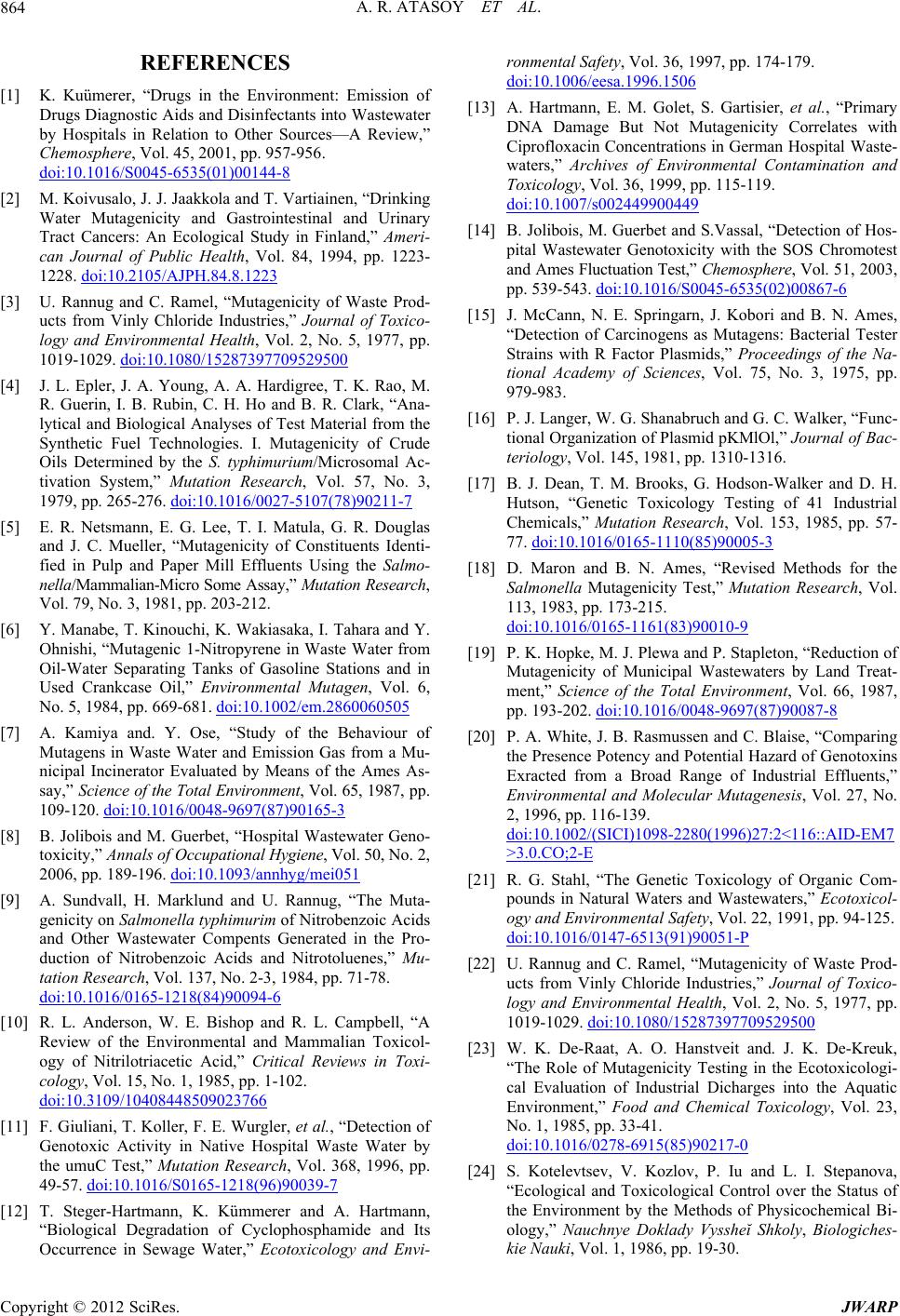
A. R. ATASOY ET AL.
864
REFERENCES
[1] K. Kuümerer, “Drugs in the Environment: Emission of
Drugs Diagnostic Aids and Disinfectants into Wastewater
by Hospitals in Relation to Other Sources—A Review,”
Chemosphere, Vol. 45, 2001, pp. 957-956.
doi:10.1016/S0045-6535(01)00144-8
[2] M. Koivusalo, J. J. Jaakkola and T. Vartiainen, “Drinking
Water Mutagenicity and Gastrointestinal and Urinary
Tract Cancers: An Ecological Study in Finland,” Ameri-
can Journal of Public Health, Vol. 84, 1994, pp. 1223-
1228. doi:10.2105/AJPH.84.8.1223
[3] U. Rannug and C. Ramel, “Mutagenicity of Waste Prod-
ucts from Vinly Chloride Industries,” Journal of Toxico-
logy and Environmental Health, Vol. 2, No. 5, 1977, pp.
1019-1029. doi:10.1080/15287397709529500
[4] J. L. Epler, J. A. Young, A. A. Hardigree, T. K. Rao, M.
R. Guerin, I. B. Rubin, C. H. Ho and B. R. Clark, “Ana-
lytical and Biological Analyses of Test Material from the
Synthetic Fuel Technologies. I. Mutagenicity of Crude
Oils Determined by the S. typhimurium/Microsomal Ac-
tivation System,” Mutation Research, Vol. 57, No. 3,
1979, pp. 265-276. doi:10.1016/0027-5107(78)90211-7
[5] E. R. Netsmann, E. G. Lee, T. I. Matula, G. R. Douglas
and J. C. Mueller, “Mutagenicity of Constituents Identi-
fied in Pulp and Paper Mill Effluents Using the Salmo-
nella/Mammalian-Micro Some Assay,” Mutation Research,
Vol. 79, No. 3, 1981, pp. 203-212.
[6] Y. Manabe, T. Kinouchi, K. Wakiasaka, I. Tahara and Y.
Ohnishi, “Mutagenic 1-Nitropyrene in Waste Water from
Oil-Water Separating Tanks of Gasoline Stations and in
Used Crankcase Oil,” Environmental Mutagen, Vol. 6,
No. 5, 1984, pp. 669-681. doi:10.1002/em.2860060505
[7] A. Kamiya and. Y. Ose, “Study of the Behaviour of
Mutagens in Waste Water and Emission Gas from a Mu-
nicipal Incinerator Evaluated by Means of the Ames As-
say,” Science of the Total Environment, Vol. 65, 1987, p p.
109-120. doi:10.1016/0048-9697(87)90165-3
[8] B. Jolibois and M. Guerbet, “Hospital Wastewater Geno-
toxicity,” Annals of Occupational Hygiene, V o l. 50, No. 2,
2006, pp. 189-196. doi:10.1093/annhyg/mei051
[9] A. Sundvall, H. Marklund and U. Rannug, “The Muta-
genicity on Salmonella typhimurim of Nitrobenzoic Acids
and Other Wastewater Compents Generated in the Pro-
duction of Nitrobenzoic Acids and Nitrotoluenes,” Mu-
tation Research, Vol. 137, No. 2-3, 1984, pp. 71-78.
doi:10.1016/0165-1218(84)90094-6
[10] R. L. Anderson, W. E. Bishop and R. L. Campbell, “A
Review of the Environmental and Mammalian Toxicol-
ogy of Nitrilotriacetic Acid,” Critical Reviews in Toxi-
cology, Vol. 15, No. 1, 1985, pp. 1-102.
doi:10.3109/10408448509023766
[11] F. Giuliani, T. Koller, F. E. Wurgler, et al., “Detection of
Genotoxic Activity in Native Hospital Waste Water by
the umuC Test,” Mutation Research, Vol. 368, 1996, pp.
49-57. doi:10.1016/S0165-1218(96)90039-7
[12] T. Steger-Hartmann, K. Kümmerer and A. Hartmann,
“Biological Degradation of Cyclophosphamide and Its
Occurrence in Sewage Water,” Ecotoxicology and Envi-
ronmental Safety, Vol. 36, 1997, pp. 174-179.
doi:10.1006/eesa.1996.1506
[13] A. Hartmann, E. M. Golet, S. Gartisier, et al., “Primary
DNA Damage But Not Mutagenicity Correlates with
Ciprofloxacin Concentrations in German Hospital Waste-
waters,” Archives of Environmental Contamination and
Toxicology, Vol. 36, 1999, pp. 115-119.
doi:10.1007/s002449900449
[14] B. Jolibois, M. Guerbet and S.Vassal, “De tection of Hos-
pital Wastewater Genotoxicity with the SOS Chromotest
an d Ames Fluct uation Test,” Chemo sphere, Vol. 51, 2003,
pp. 539-543. doi:10.1016/S0045-6535(02)00867-6
[15] J. McCann, N. E. Springarn, J. Kobori and B. N. Ames,
“Detection of Carcinogens as Mutagens: Bacterial Tester
Strains with R Factor Plasmids,” Proceedings of the Na-
tional Academy of Sciences, Vol. 75, No. 3, 1975, pp.
979-983.
[16] P. J. Langer, W. G. Shanabruch and G. C. Walker, “Func-
tional Organization of Plasmid pKMlOl, ” Journal of Bac-
teriology, Vol. 145, 1981, pp. 1310-1316.
[17] B. J. Dean, T. M. Brooks, G. Hodson-Walker and D. H.
Hutson, “Genetic Toxicology Testing of 41 Industrial
Chemicals,” Mutation Research, Vol. 153, 1985, pp. 57-
77. doi:10.1016/0165-1110(85)90005-3
[18] D. Maron and B. N. Ames, “Revised Methods for the
Salmonella Mutagenicity Test,” Mutation Research, Vol.
113, 1983, pp. 173-215.
doi:10.1016/0165-1161(83)90010-9
[19] P. K. Hopke, M. J. Plewa and P. Stapleton, “Reduction of
Mutagenicity of Municipal Wastewaters by Land Treat-
ment,” Science of the Total Environment, Vol. 66, 1987,
pp. 193-202. doi:10.1016/0048-9697(87)90087-8
[20] P. A. White, J. B. Rasmussen and C. Blaise, “Comparing
the Presence Potency and Potential Hazard of Genotoxins
Exracted from a Broad Range of Industrial Effluents,”
Environmental and Molecular Mutagenesis, Vol. 27, No.
2, 1996, pp. 116-139.
doi:10.1002/(SICI)1098-2280(1996)27:2<116::AID-EM7
>3.0.CO;2-E
[21] R. G. Stahl, “The Genetic Toxicology of Organic Com-
pounds in Natural Waters and Wastewaters,” Ecotoxicol-
ogy and Environmental Safety, Vol. 22, 1991, pp. 94-125.
doi:10.1016/0147-6513(91)90051-P
[22] U. Rannug and C. Ramel, “Mutagenicity of Waste Prod-
ucts from Vinly Chloride Industries,” Journal of Toxico-
logy and Environmental Health, Vol. 2, No. 5, 1977, pp.
1019-1029. doi:10.1080/15287397709529500
[23] W. K. De-Raat, A. O. Hanstveit and. J. K. De-Kreuk,
“The Role of Mutagenicity Testing in the Ecotoxicologi-
cal Evaluation of Industrial Dicharges into the Aquatic
Environment,” Food and Chemical Toxicology, Vol. 23,
No. 1, 1985, pp. 33-41.
doi:10.1016/0278-6915(85)90217-0
[24] S. Kotelevtsev, V. Kozlov, P. Iu and L. I. Stepanova,
“Ecological and Toxicological Control over the Status of
the Environment by the Methods of Physicochemical Bi-
ology,” Nauchnye Doklady Vyssheĭ Shkoly, Biologiches-
kie Nauki, Vol. 1, 1986, pp. 19-30.
Copyright © 2012 SciRes. JWARP